Analysis of Headspace System: Cloud, SDLC, Requirements
VerifiedAdded on 2020/04/07
|10
|1783
|278
Report
AI Summary
This report provides a detailed analysis of the Headspace system, covering its non-functional requirements, a review of cloud-based solutions, and a comparison of Software Development Life Cycle (SDLC) approaches. The non-functional requirements discussed include usability, reliability, performance, and security. The report reviews the strengths and weaknesses of Platform as a Service (PaaS) cloud-based solutions, highlighting flexibility, disaster recovery, and increased collaboration as strengths, while noting downtime, reduced security, and less control as weaknesses. The report then compares predictive and adaptive SDLC approaches, outlining the advantages and disadvantages of each, and concludes by recommending the predictive approach for the Headspace system implementation based on the project's characteristics. The report also includes a comprehensive list of references to support its findings.
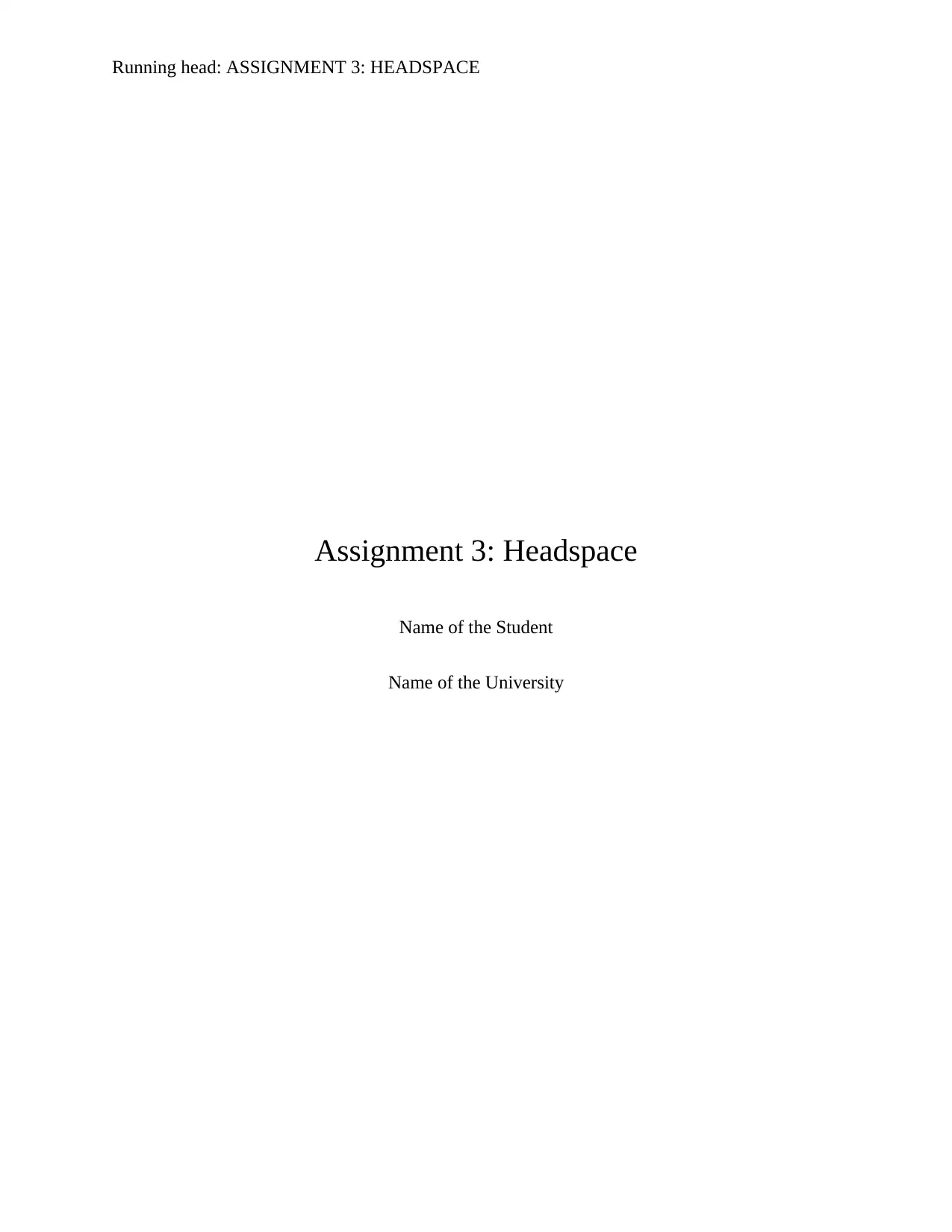
Running head: ASSIGNMENT 3: HEADSPACE
Assignment 3: Headspace
Name of the Student
Name of the University
Assignment 3: Headspace
Name of the Student
Name of the University
Paraphrase This Document
Need a fresh take? Get an instant paraphrase of this document with our AI Paraphraser
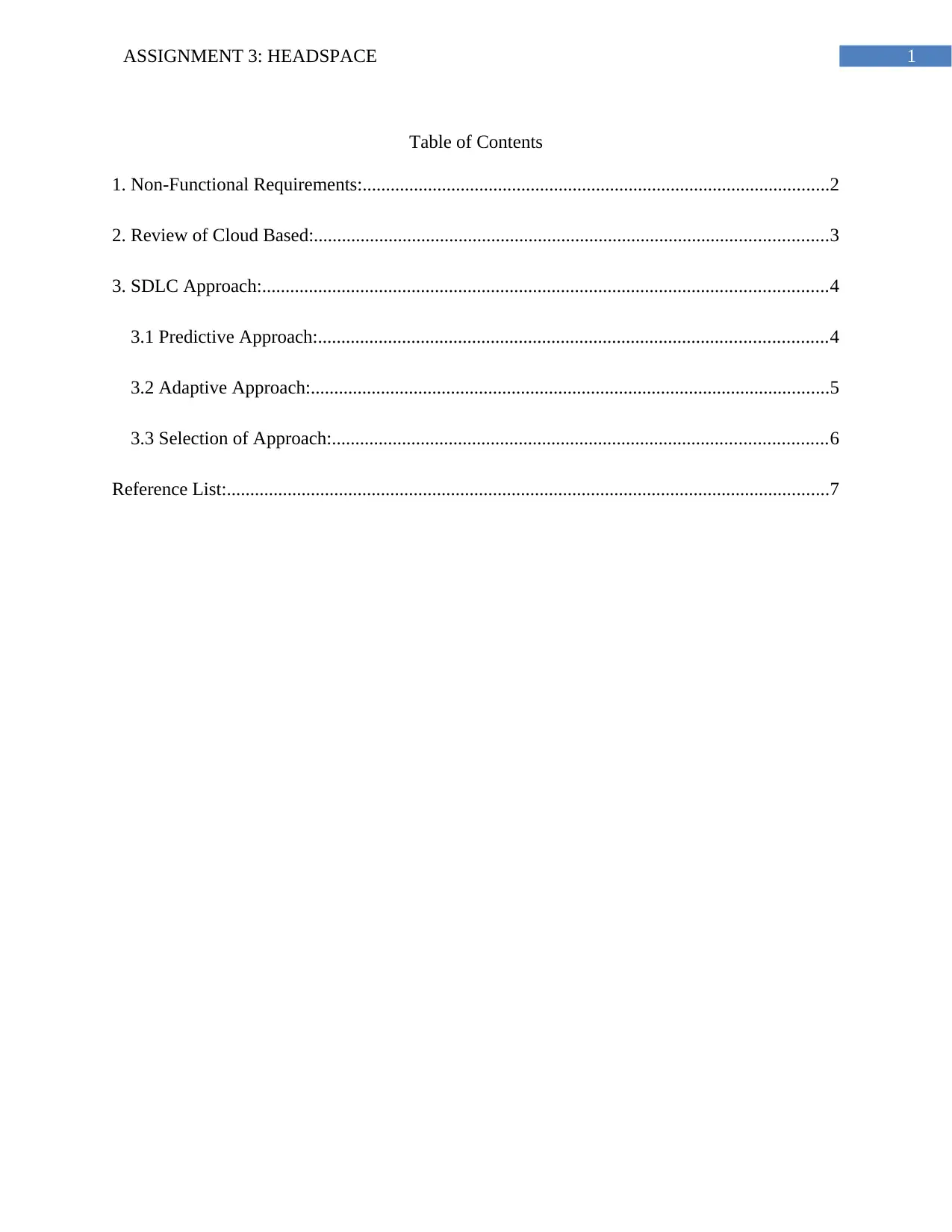
1ASSIGNMENT 3: HEADSPACE
Table of Contents
1. Non-Functional Requirements:....................................................................................................2
2. Review of Cloud Based:..............................................................................................................3
3. SDLC Approach:.........................................................................................................................4
3.1 Predictive Approach:.............................................................................................................4
3.2 Adaptive Approach:...............................................................................................................5
3.3 Selection of Approach:..........................................................................................................6
Reference List:.................................................................................................................................7
Table of Contents
1. Non-Functional Requirements:....................................................................................................2
2. Review of Cloud Based:..............................................................................................................3
3. SDLC Approach:.........................................................................................................................4
3.1 Predictive Approach:.............................................................................................................4
3.2 Adaptive Approach:...............................................................................................................5
3.3 Selection of Approach:..........................................................................................................6
Reference List:.................................................................................................................................7
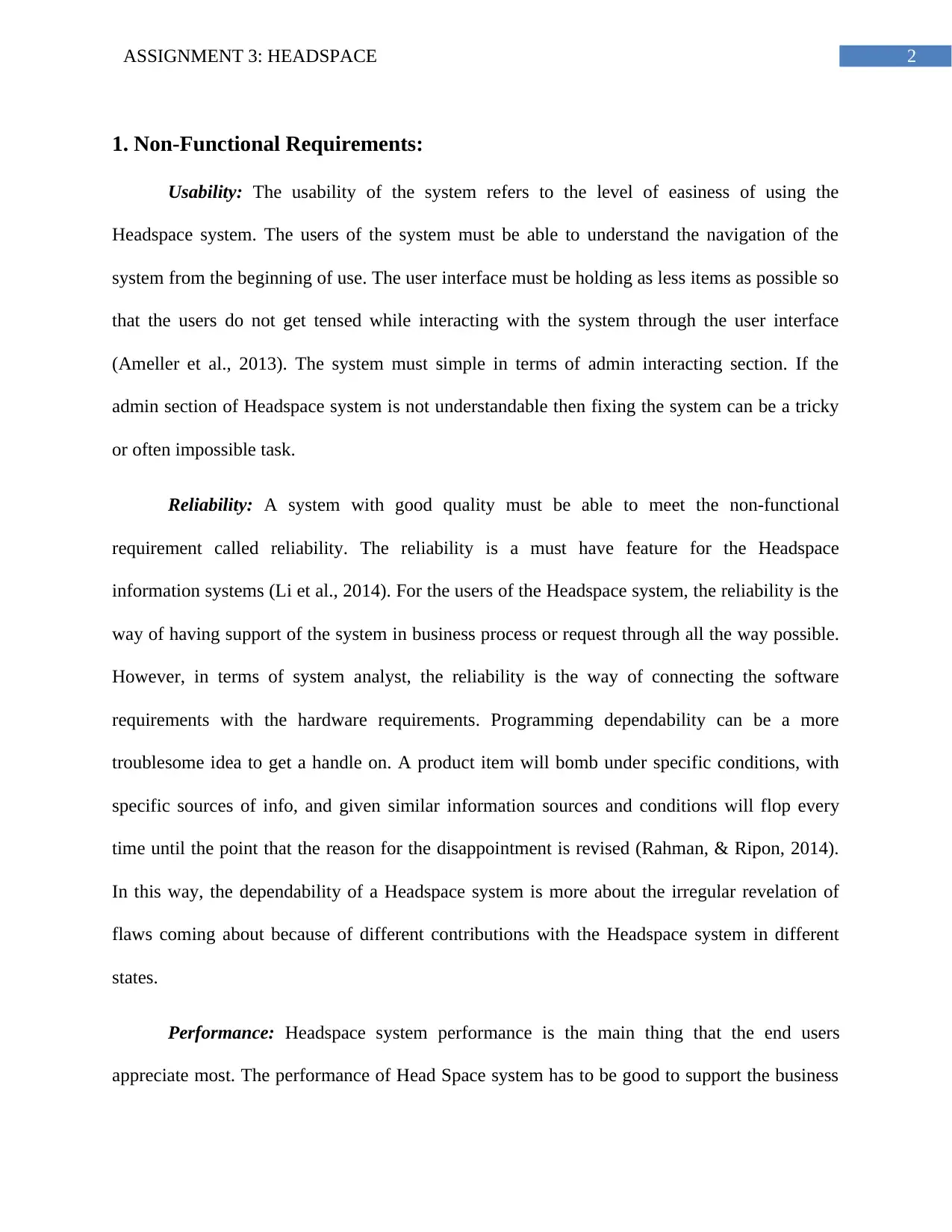
2ASSIGNMENT 3: HEADSPACE
1. Non-Functional Requirements:
Usability: The usability of the system refers to the level of easiness of using the
Headspace system. The users of the system must be able to understand the navigation of the
system from the beginning of use. The user interface must be holding as less items as possible so
that the users do not get tensed while interacting with the system through the user interface
(Ameller et al., 2013). The system must simple in terms of admin interacting section. If the
admin section of Headspace system is not understandable then fixing the system can be a tricky
or often impossible task.
Reliability: A system with good quality must be able to meet the non-functional
requirement called reliability. The reliability is a must have feature for the Headspace
information systems (Li et al., 2014). For the users of the Headspace system, the reliability is the
way of having support of the system in business process or request through all the way possible.
However, in terms of system analyst, the reliability is the way of connecting the software
requirements with the hardware requirements. Programming dependability can be a more
troublesome idea to get a handle on. A product item will bomb under specific conditions, with
specific sources of info, and given similar information sources and conditions will flop every
time until the point that the reason for the disappointment is revised (Rahman, & Ripon, 2014).
In this way, the dependability of a Headspace system is more about the irregular revelation of
flaws coming about because of different contributions with the Headspace system in different
states.
Performance: Headspace system performance is the main thing that the end users
appreciate most. The performance of Head Space system has to be good to support the business
1. Non-Functional Requirements:
Usability: The usability of the system refers to the level of easiness of using the
Headspace system. The users of the system must be able to understand the navigation of the
system from the beginning of use. The user interface must be holding as less items as possible so
that the users do not get tensed while interacting with the system through the user interface
(Ameller et al., 2013). The system must simple in terms of admin interacting section. If the
admin section of Headspace system is not understandable then fixing the system can be a tricky
or often impossible task.
Reliability: A system with good quality must be able to meet the non-functional
requirement called reliability. The reliability is a must have feature for the Headspace
information systems (Li et al., 2014). For the users of the Headspace system, the reliability is the
way of having support of the system in business process or request through all the way possible.
However, in terms of system analyst, the reliability is the way of connecting the software
requirements with the hardware requirements. Programming dependability can be a more
troublesome idea to get a handle on. A product item will bomb under specific conditions, with
specific sources of info, and given similar information sources and conditions will flop every
time until the point that the reason for the disappointment is revised (Rahman, & Ripon, 2014).
In this way, the dependability of a Headspace system is more about the irregular revelation of
flaws coming about because of different contributions with the Headspace system in different
states.
Performance: Headspace system performance is the main thing that the end users
appreciate most. The performance of Head Space system has to be good to support the business
⊘ This is a preview!⊘
Do you want full access?
Subscribe today to unlock all pages.

Trusted by 1+ million students worldwide
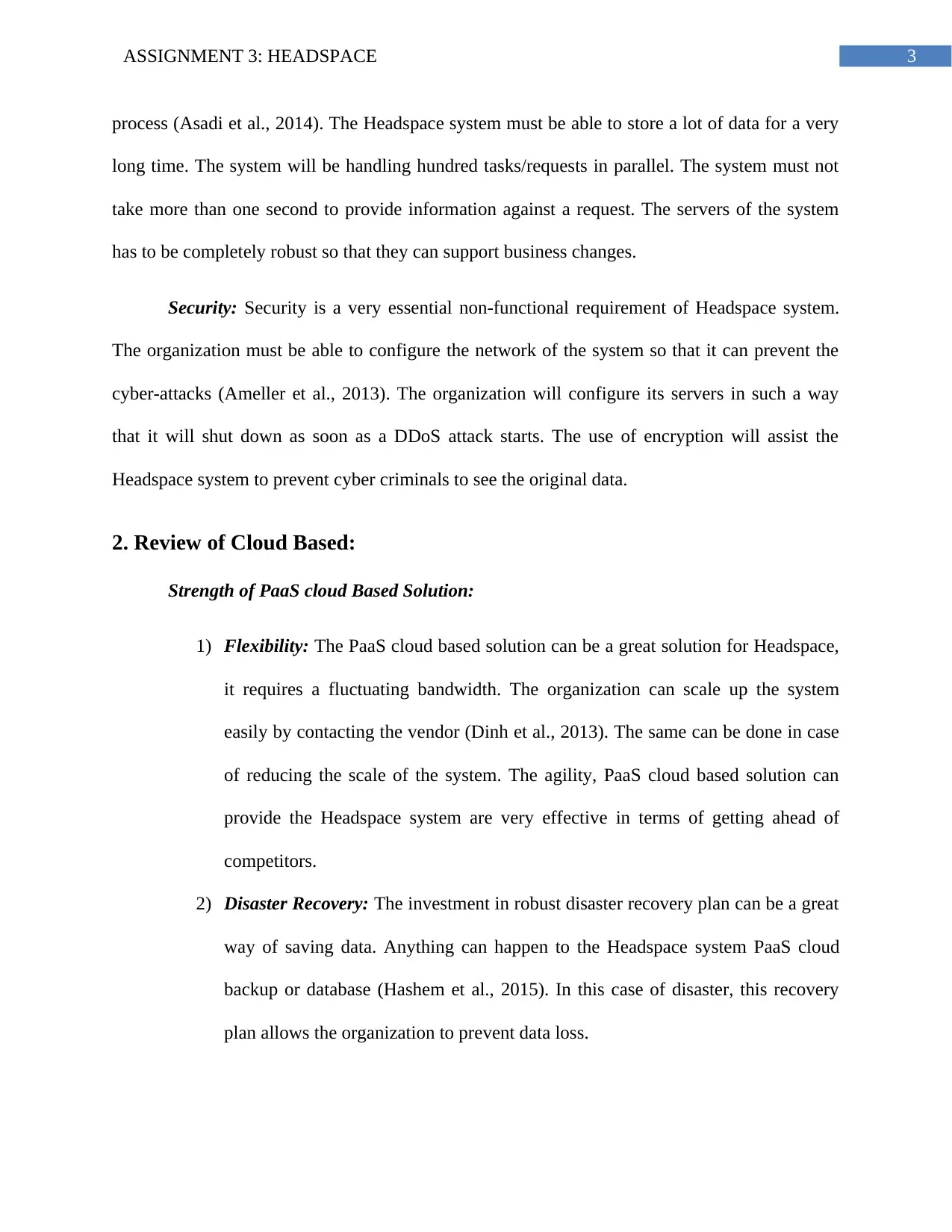
3ASSIGNMENT 3: HEADSPACE
process (Asadi et al., 2014). The Headspace system must be able to store a lot of data for a very
long time. The system will be handling hundred tasks/requests in parallel. The system must not
take more than one second to provide information against a request. The servers of the system
has to be completely robust so that they can support business changes.
Security: Security is a very essential non-functional requirement of Headspace system.
The organization must be able to configure the network of the system so that it can prevent the
cyber-attacks (Ameller et al., 2013). The organization will configure its servers in such a way
that it will shut down as soon as a DDoS attack starts. The use of encryption will assist the
Headspace system to prevent cyber criminals to see the original data.
2. Review of Cloud Based:
Strength of PaaS cloud Based Solution:
1) Flexibility: The PaaS cloud based solution can be a great solution for Headspace,
it requires a fluctuating bandwidth. The organization can scale up the system
easily by contacting the vendor (Dinh et al., 2013). The same can be done in case
of reducing the scale of the system. The agility, PaaS cloud based solution can
provide the Headspace system are very effective in terms of getting ahead of
competitors.
2) Disaster Recovery: The investment in robust disaster recovery plan can be a great
way of saving data. Anything can happen to the Headspace system PaaS cloud
backup or database (Hashem et al., 2015). In this case of disaster, this recovery
plan allows the organization to prevent data loss.
process (Asadi et al., 2014). The Headspace system must be able to store a lot of data for a very
long time. The system will be handling hundred tasks/requests in parallel. The system must not
take more than one second to provide information against a request. The servers of the system
has to be completely robust so that they can support business changes.
Security: Security is a very essential non-functional requirement of Headspace system.
The organization must be able to configure the network of the system so that it can prevent the
cyber-attacks (Ameller et al., 2013). The organization will configure its servers in such a way
that it will shut down as soon as a DDoS attack starts. The use of encryption will assist the
Headspace system to prevent cyber criminals to see the original data.
2. Review of Cloud Based:
Strength of PaaS cloud Based Solution:
1) Flexibility: The PaaS cloud based solution can be a great solution for Headspace,
it requires a fluctuating bandwidth. The organization can scale up the system
easily by contacting the vendor (Dinh et al., 2013). The same can be done in case
of reducing the scale of the system. The agility, PaaS cloud based solution can
provide the Headspace system are very effective in terms of getting ahead of
competitors.
2) Disaster Recovery: The investment in robust disaster recovery plan can be a great
way of saving data. Anything can happen to the Headspace system PaaS cloud
backup or database (Hashem et al., 2015). In this case of disaster, this recovery
plan allows the organization to prevent data loss.
Paraphrase This Document
Need a fresh take? Get an instant paraphrase of this document with our AI Paraphraser
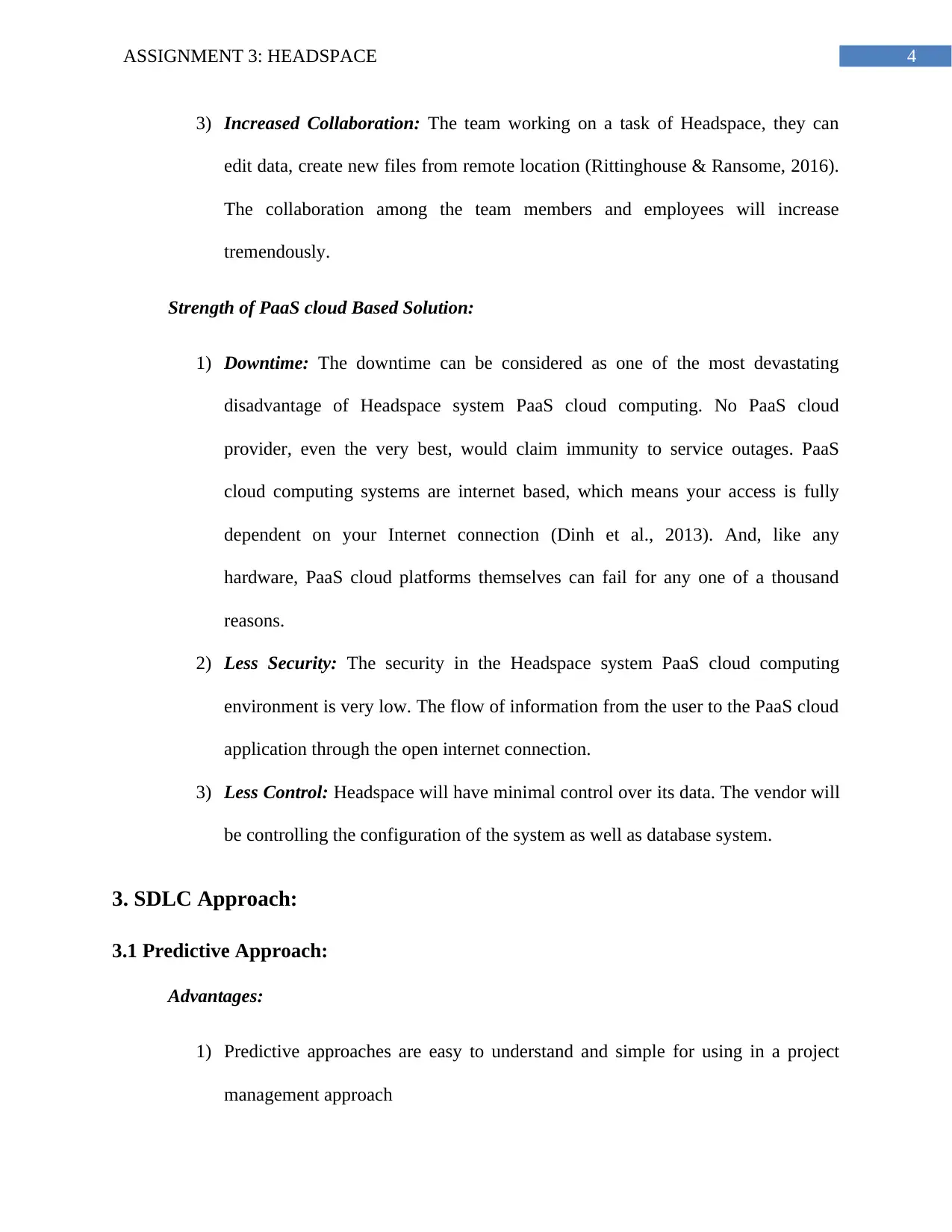
4ASSIGNMENT 3: HEADSPACE
3) Increased Collaboration: The team working on a task of Headspace, they can
edit data, create new files from remote location (Rittinghouse & Ransome, 2016).
The collaboration among the team members and employees will increase
tremendously.
Strength of PaaS cloud Based Solution:
1) Downtime: The downtime can be considered as one of the most devastating
disadvantage of Headspace system PaaS cloud computing. No PaaS cloud
provider, even the very best, would claim immunity to service outages. PaaS
cloud computing systems are internet based, which means your access is fully
dependent on your Internet connection (Dinh et al., 2013). And, like any
hardware, PaaS cloud platforms themselves can fail for any one of a thousand
reasons.
2) Less Security: The security in the Headspace system PaaS cloud computing
environment is very low. The flow of information from the user to the PaaS cloud
application through the open internet connection.
3) Less Control: Headspace will have minimal control over its data. The vendor will
be controlling the configuration of the system as well as database system.
3. SDLC Approach:
3.1 Predictive Approach:
Advantages:
1) Predictive approaches are easy to understand and simple for using in a project
management approach
3) Increased Collaboration: The team working on a task of Headspace, they can
edit data, create new files from remote location (Rittinghouse & Ransome, 2016).
The collaboration among the team members and employees will increase
tremendously.
Strength of PaaS cloud Based Solution:
1) Downtime: The downtime can be considered as one of the most devastating
disadvantage of Headspace system PaaS cloud computing. No PaaS cloud
provider, even the very best, would claim immunity to service outages. PaaS
cloud computing systems are internet based, which means your access is fully
dependent on your Internet connection (Dinh et al., 2013). And, like any
hardware, PaaS cloud platforms themselves can fail for any one of a thousand
reasons.
2) Less Security: The security in the Headspace system PaaS cloud computing
environment is very low. The flow of information from the user to the PaaS cloud
application through the open internet connection.
3) Less Control: Headspace will have minimal control over its data. The vendor will
be controlling the configuration of the system as well as database system.
3. SDLC Approach:
3.1 Predictive Approach:
Advantages:
1) Predictive approaches are easy to understand and simple for using in a project
management approach
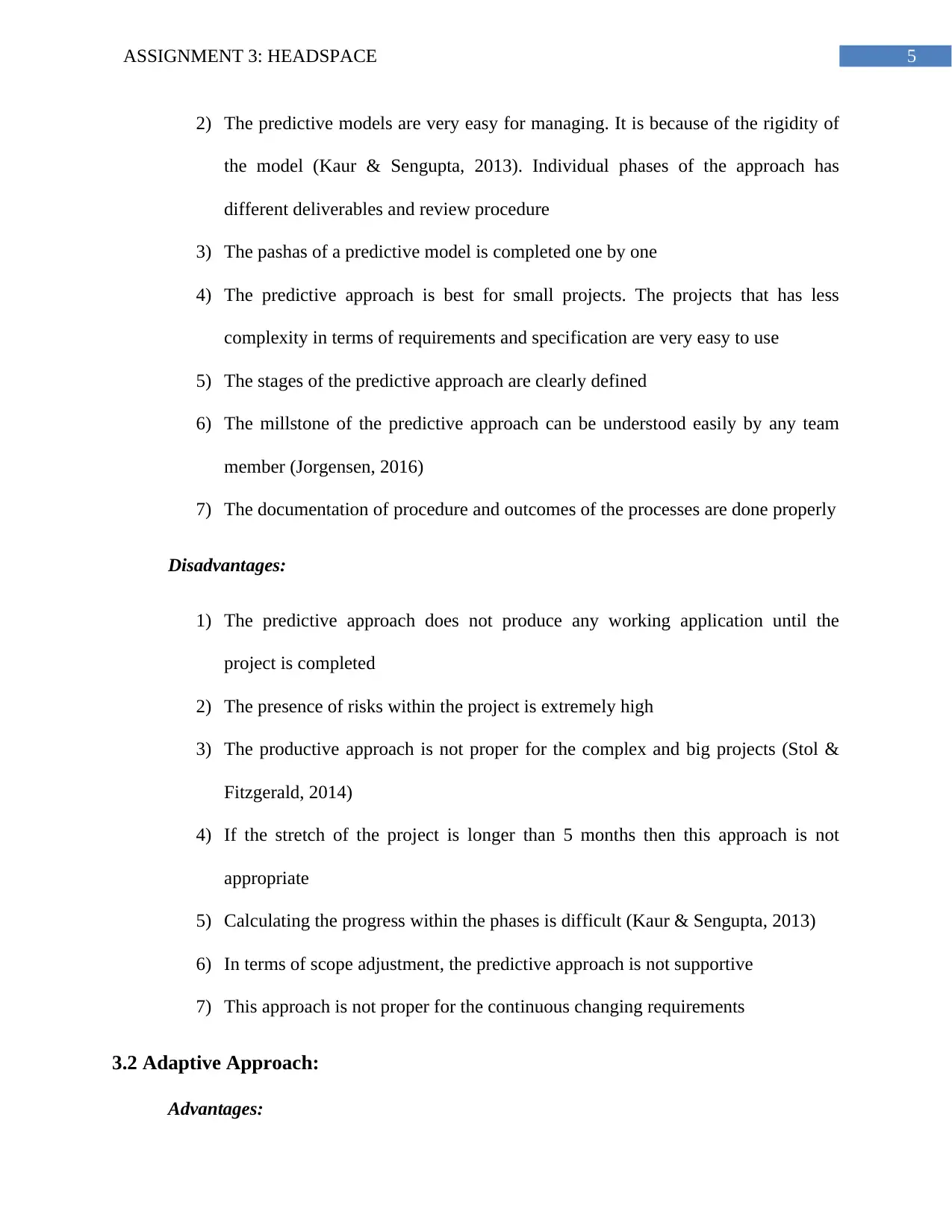
5ASSIGNMENT 3: HEADSPACE
2) The predictive models are very easy for managing. It is because of the rigidity of
the model (Kaur & Sengupta, 2013). Individual phases of the approach has
different deliverables and review procedure
3) The pashas of a predictive model is completed one by one
4) The predictive approach is best for small projects. The projects that has less
complexity in terms of requirements and specification are very easy to use
5) The stages of the predictive approach are clearly defined
6) The millstone of the predictive approach can be understood easily by any team
member (Jorgensen, 2016)
7) The documentation of procedure and outcomes of the processes are done properly
Disadvantages:
1) The predictive approach does not produce any working application until the
project is completed
2) The presence of risks within the project is extremely high
3) The productive approach is not proper for the complex and big projects (Stol &
Fitzgerald, 2014)
4) If the stretch of the project is longer than 5 months then this approach is not
appropriate
5) Calculating the progress within the phases is difficult (Kaur & Sengupta, 2013)
6) In terms of scope adjustment, the predictive approach is not supportive
7) This approach is not proper for the continuous changing requirements
3.2 Adaptive Approach:
Advantages:
2) The predictive models are very easy for managing. It is because of the rigidity of
the model (Kaur & Sengupta, 2013). Individual phases of the approach has
different deliverables and review procedure
3) The pashas of a predictive model is completed one by one
4) The predictive approach is best for small projects. The projects that has less
complexity in terms of requirements and specification are very easy to use
5) The stages of the predictive approach are clearly defined
6) The millstone of the predictive approach can be understood easily by any team
member (Jorgensen, 2016)
7) The documentation of procedure and outcomes of the processes are done properly
Disadvantages:
1) The predictive approach does not produce any working application until the
project is completed
2) The presence of risks within the project is extremely high
3) The productive approach is not proper for the complex and big projects (Stol &
Fitzgerald, 2014)
4) If the stretch of the project is longer than 5 months then this approach is not
appropriate
5) Calculating the progress within the phases is difficult (Kaur & Sengupta, 2013)
6) In terms of scope adjustment, the predictive approach is not supportive
7) This approach is not proper for the continuous changing requirements
3.2 Adaptive Approach:
Advantages:
⊘ This is a preview!⊘
Do you want full access?
Subscribe today to unlock all pages.

Trusted by 1+ million students worldwide
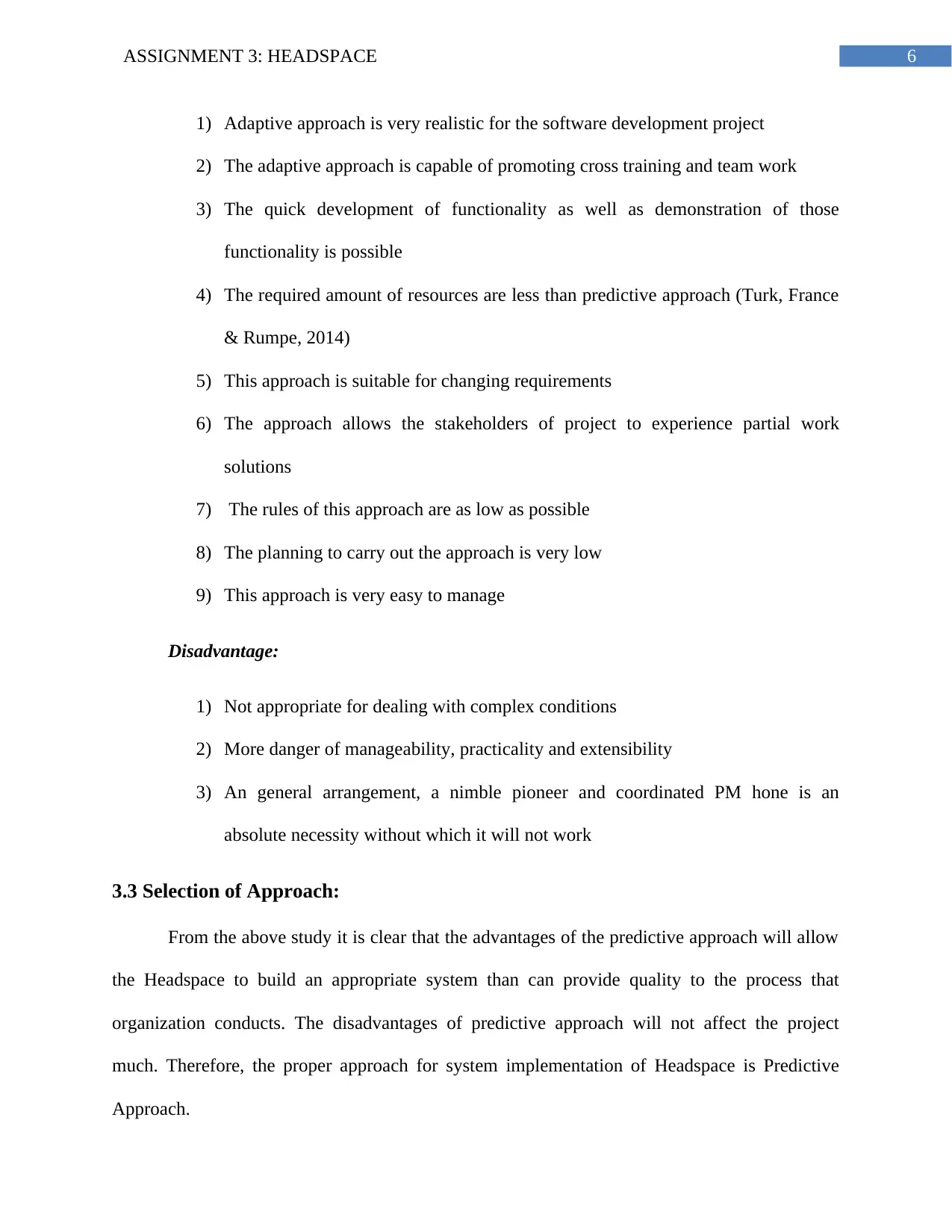
6ASSIGNMENT 3: HEADSPACE
1) Adaptive approach is very realistic for the software development project
2) The adaptive approach is capable of promoting cross training and team work
3) The quick development of functionality as well as demonstration of those
functionality is possible
4) The required amount of resources are less than predictive approach (Turk, France
& Rumpe, 2014)
5) This approach is suitable for changing requirements
6) The approach allows the stakeholders of project to experience partial work
solutions
7) The rules of this approach are as low as possible
8) The planning to carry out the approach is very low
9) This approach is very easy to manage
Disadvantage:
1) Not appropriate for dealing with complex conditions
2) More danger of manageability, practicality and extensibility
3) An general arrangement, a nimble pioneer and coordinated PM hone is an
absolute necessity without which it will not work
3.3 Selection of Approach:
From the above study it is clear that the advantages of the predictive approach will allow
the Headspace to build an appropriate system than can provide quality to the process that
organization conducts. The disadvantages of predictive approach will not affect the project
much. Therefore, the proper approach for system implementation of Headspace is Predictive
Approach.
1) Adaptive approach is very realistic for the software development project
2) The adaptive approach is capable of promoting cross training and team work
3) The quick development of functionality as well as demonstration of those
functionality is possible
4) The required amount of resources are less than predictive approach (Turk, France
& Rumpe, 2014)
5) This approach is suitable for changing requirements
6) The approach allows the stakeholders of project to experience partial work
solutions
7) The rules of this approach are as low as possible
8) The planning to carry out the approach is very low
9) This approach is very easy to manage
Disadvantage:
1) Not appropriate for dealing with complex conditions
2) More danger of manageability, practicality and extensibility
3) An general arrangement, a nimble pioneer and coordinated PM hone is an
absolute necessity without which it will not work
3.3 Selection of Approach:
From the above study it is clear that the advantages of the predictive approach will allow
the Headspace to build an appropriate system than can provide quality to the process that
organization conducts. The disadvantages of predictive approach will not affect the project
much. Therefore, the proper approach for system implementation of Headspace is Predictive
Approach.
Paraphrase This Document
Need a fresh take? Get an instant paraphrase of this document with our AI Paraphraser

7ASSIGNMENT 3: HEADSPACE
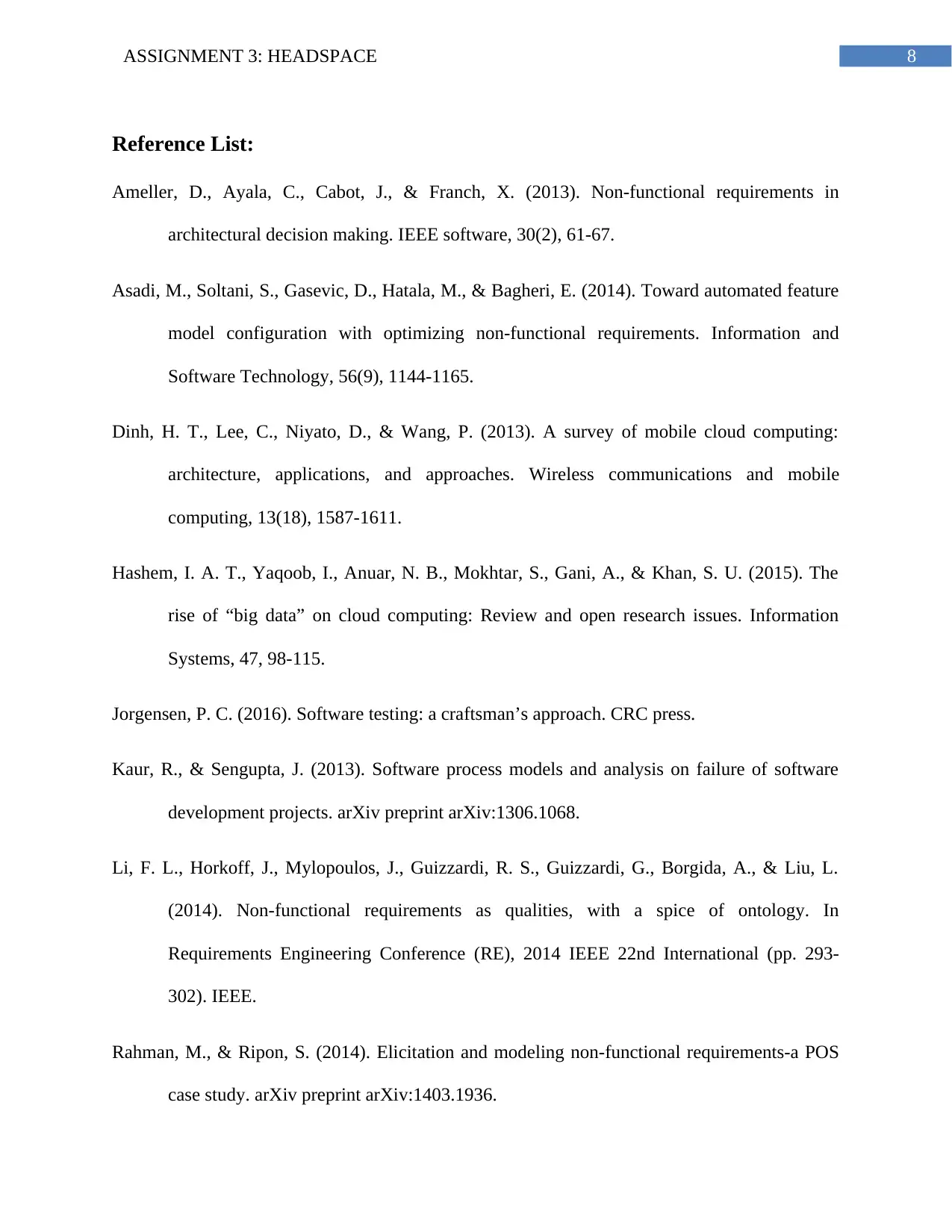
8ASSIGNMENT 3: HEADSPACE
Reference List:
Ameller, D., Ayala, C., Cabot, J., & Franch, X. (2013). Non-functional requirements in
architectural decision making. IEEE software, 30(2), 61-67.
Asadi, M., Soltani, S., Gasevic, D., Hatala, M., & Bagheri, E. (2014). Toward automated feature
model configuration with optimizing non-functional requirements. Information and
Software Technology, 56(9), 1144-1165.
Dinh, H. T., Lee, C., Niyato, D., & Wang, P. (2013). A survey of mobile cloud computing:
architecture, applications, and approaches. Wireless communications and mobile
computing, 13(18), 1587-1611.
Hashem, I. A. T., Yaqoob, I., Anuar, N. B., Mokhtar, S., Gani, A., & Khan, S. U. (2015). The
rise of “big data” on cloud computing: Review and open research issues. Information
Systems, 47, 98-115.
Jorgensen, P. C. (2016). Software testing: a craftsman’s approach. CRC press.
Kaur, R., & Sengupta, J. (2013). Software process models and analysis on failure of software
development projects. arXiv preprint arXiv:1306.1068.
Li, F. L., Horkoff, J., Mylopoulos, J., Guizzardi, R. S., Guizzardi, G., Borgida, A., & Liu, L.
(2014). Non-functional requirements as qualities, with a spice of ontology. In
Requirements Engineering Conference (RE), 2014 IEEE 22nd International (pp. 293-
302). IEEE.
Rahman, M., & Ripon, S. (2014). Elicitation and modeling non-functional requirements-a POS
case study. arXiv preprint arXiv:1403.1936.
Reference List:
Ameller, D., Ayala, C., Cabot, J., & Franch, X. (2013). Non-functional requirements in
architectural decision making. IEEE software, 30(2), 61-67.
Asadi, M., Soltani, S., Gasevic, D., Hatala, M., & Bagheri, E. (2014). Toward automated feature
model configuration with optimizing non-functional requirements. Information and
Software Technology, 56(9), 1144-1165.
Dinh, H. T., Lee, C., Niyato, D., & Wang, P. (2013). A survey of mobile cloud computing:
architecture, applications, and approaches. Wireless communications and mobile
computing, 13(18), 1587-1611.
Hashem, I. A. T., Yaqoob, I., Anuar, N. B., Mokhtar, S., Gani, A., & Khan, S. U. (2015). The
rise of “big data” on cloud computing: Review and open research issues. Information
Systems, 47, 98-115.
Jorgensen, P. C. (2016). Software testing: a craftsman’s approach. CRC press.
Kaur, R., & Sengupta, J. (2013). Software process models and analysis on failure of software
development projects. arXiv preprint arXiv:1306.1068.
Li, F. L., Horkoff, J., Mylopoulos, J., Guizzardi, R. S., Guizzardi, G., Borgida, A., & Liu, L.
(2014). Non-functional requirements as qualities, with a spice of ontology. In
Requirements Engineering Conference (RE), 2014 IEEE 22nd International (pp. 293-
302). IEEE.
Rahman, M., & Ripon, S. (2014). Elicitation and modeling non-functional requirements-a POS
case study. arXiv preprint arXiv:1403.1936.
⊘ This is a preview!⊘
Do you want full access?
Subscribe today to unlock all pages.

Trusted by 1+ million students worldwide
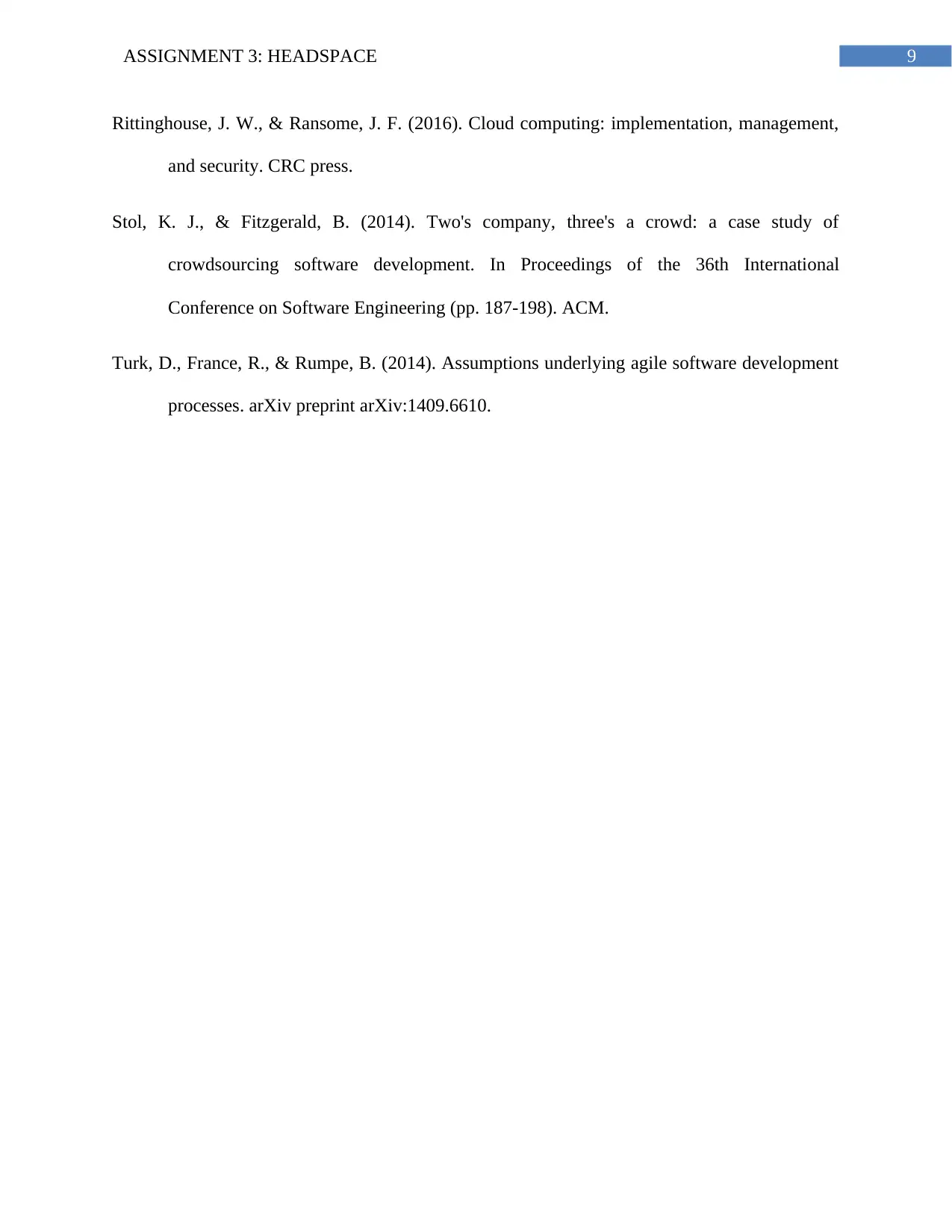
9ASSIGNMENT 3: HEADSPACE
Rittinghouse, J. W., & Ransome, J. F. (2016). Cloud computing: implementation, management,
and security. CRC press.
Stol, K. J., & Fitzgerald, B. (2014). Two's company, three's a crowd: a case study of
crowdsourcing software development. In Proceedings of the 36th International
Conference on Software Engineering (pp. 187-198). ACM.
Turk, D., France, R., & Rumpe, B. (2014). Assumptions underlying agile software development
processes. arXiv preprint arXiv:1409.6610.
Rittinghouse, J. W., & Ransome, J. F. (2016). Cloud computing: implementation, management,
and security. CRC press.
Stol, K. J., & Fitzgerald, B. (2014). Two's company, three's a crowd: a case study of
crowdsourcing software development. In Proceedings of the 36th International
Conference on Software Engineering (pp. 187-198). ACM.
Turk, D., France, R., & Rumpe, B. (2014). Assumptions underlying agile software development
processes. arXiv preprint arXiv:1409.6610.
1 out of 10
Related Documents
Your All-in-One AI-Powered Toolkit for Academic Success.
+13062052269
info@desklib.com
Available 24*7 on WhatsApp / Email
![[object Object]](/_next/static/media/star-bottom.7253800d.svg)
Unlock your academic potential
Copyright © 2020–2025 A2Z Services. All Rights Reserved. Developed and managed by ZUCOL.





